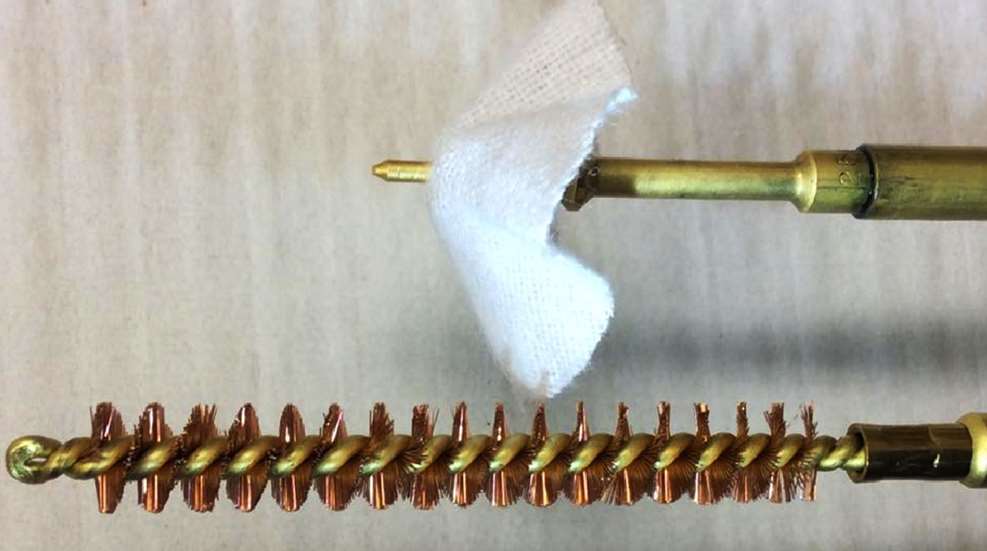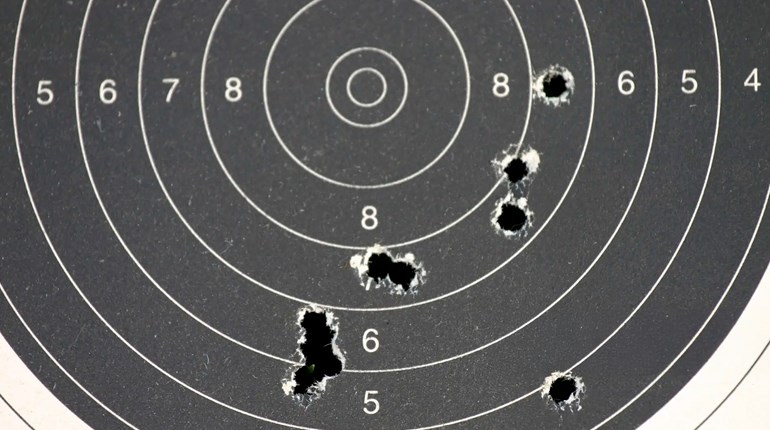
Above: Still the best―quality rods, brushes, patches and solvents.
In this article, we shift from handloading to rifle bore cleaning and maintenance, with information courtesy of the U.S. Army Marksmanship Unit’s (AMU) Custom Firearms Shop. After all, even the best handloads won’t yield their full potential in a poorly-cleaned and maintained rifle.
Bore Snakes: Miracle replacement for the cleaning rod?
The experiences of both our firearms test specialist and this writer have given no evidence that proper use of a clean bore snake will damage a match barrel. Of course, one does not pull the bore snake at an angle to the crown when removing it—pull it straight out, parallel to the bore's direction, to prevent crown wear over time.
Bore snakes are very useful for some applications (primarily a hasty, interim wipe-down). In this writer’s experience they cannot replace a thorough cleaning with a proper rod and brushes. While the experiment cited here involves rimfire, it may help illustrate. Several years ago, the writer used his new, personal Anschutz to investigate the bore snake issue. It had fired approximately 350 rounds with match ammo and had three typical rod/brush cleanings.
Next, starting with a clean bore, the writer fired 300 more rounds without cleaning in order to build up a “worst-case” fouling condition. Afterwards, the writer examined the bore with a Hawkeye borescope. There was a uniform, grey film down the entire barrel, with some small, intermittent lead build-up at and just forward of the throat.
A new bore snake was then wet with solvent and pulled through the bore. The Hawkeye revealed that the grey fouling was gone, and much of the visible fouling at the throat was reduced. However, nine more passes with the bore snake, checking after each with the Hawkeye, revealed no further improvement in cleaning. The writer then cleaned with two wet patches, observed, then one stroke of a new, wet bronze brush, and one wet patch to clean out residue.
The Hawkeye showed a significant reduction in fouling at the throat; it was virtually gone. A second pass with a wet bronze brush and a wet patch removed the remaining fouling. Scrubbing the bore further, checking to see how much fouling was removed, revealed no significant improvement. The reason for this test was to learn what's needed to get (and keep) this Anschutz clean with minimal cleaning rod use—and thus, minimal risk of bore damage or wear. Leaving fouling in the bore promotes corrosion over time.
Obviously, this applies to a nice, smooth rimfire match barrel, using good, well-lubricated ammo. It doesn't apply directly to the use of copper-jacketed bullets, which leave a stubborn fouling all their own. However, it does suggest that while the bore snake can be helpful and a useful field-expedient, to truly clean a rifle barrel one will still need a good quality rod, bronze brush and solvents.
What about bore snakes for barrel break-in?
The goal of barrel break-in is to fire each shot through a clean barrel, preventing copper buildup and allowing the bullets their best chance at burnishing sharp edges. Thus, it seems this purpose would be best served by one’s usual rods, brushes and rod guides.
Don’t be that guy!
The writer was shown a very nice, 1937 German Kar-98K Mauser that, until recently, had had a pristine bore. The owner, a young veteran just back from Afghanistan, had test-fired his new rifle with corrosive surplus ammunition and then “cleaned” it with a few passes of a solvent-soaked bore snake.
Into the closet it went, only to emerge a couple of months later sporting a bright red, rusty bore with areas of heavy pitting. Unfortunately, nothing in this fellow’s career had prepared him to properly clean after corrosive-primed ammo.
For those who don’t dabble in the black arts of “milsurps,” this ammo requires water to neutralize salts from the priming compound, plus *lots* of scrubbing to remove the heavy carbon deposits from crude, 1980s Warsaw Pact-era vintage gunpowder.
After a thorough cleaning, the borescope revealed that the rifle had had a perfect crown and throat, with no firing erosion, cleaning rod damage, etc. Of course, the chunks of what had once been rifling that came out during cleaning were demoralizing, to say the least.
This Mauser had managed to survive WWII in fine shape—from 1937 to 2014—until an unfortunate encounter with a younger shooter and his “quick ‘n easy” bore snake. The writer cannot emphasize enough the benefits of thorough cleaning with quality rods, brushes, solvents and patches.
SSUSA thanks the U.S. Army Marksmanship Unit for allowing the reprint of this article.

































